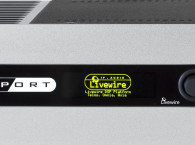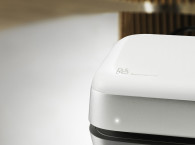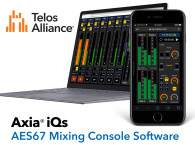
Z/IPStream is the third generation of professional streaming-audio products that originated when Telos launched the world’s first MPEG streaming hardware, the AudioActive Encoder, in 1996. In 2002, Telos leveraged that experience, introducing Omnia A/X, the first native PC software to combine audio processing, stream encoding, and integration with third-party streaming servers. Now, the Z/IPStream family includes software, hardware and plug-in PC cards — allowing any type of operational philosophy.
According to Marty Sacks, Telos’ Vice President of Sales, Support and Marketing, “The playing field has changed dramatically for broadcasters, almost overnight. Where over-the-air used to be king, radio is now fighting for listeners on smartphones, tablets, laptops and even in connected car dashboards.
“That’s why we developed Z/IPStream,” says Sacks. “All of our experience leading the way in audio coding and audio processing is poured into these products; broadcasters can easily use them to attract and lock in listeners on any digital platform.”

Z/IPStream X/2 and Z/IPStream 9X/2 are Telos’ third-generation of audio streaming software, with audio processing tools from Omnia developed to precisely condition audio for bit-reduction.
Z/IPStream X/2 runs on a standard Windows PC, simultaneously processing and encoding multiple Web streams. Z/IPStream X/2 comes with a number of expertly-tuned processing presets that give amazing results without tweaking, but power users can take advantage of the built-in, adjustable wide-band AGC, three-band compressor/limiter, EQ and precision look-ahead final limiter to craft a signature sound that matches the station’s over-the-air signal.
After processing, Z/IPStream Adaptive Streaming support simultaneously encodes audio at multiple bitrates; the listener’s player automatically chooses the best one for their available bandwidth, and even seamlessly switching bitrates if network conditions change. Z/IPStream X/2 and Z/IPStream 9X/2 support both Microsoft Smooth Streaming and Apple HLS technologies, encoding the same stream at multiple bitrates and keeping audio packets sample-aligned.
Z/IPStream 9X/2 also features more audio processing power by including Omnia.9 audio processing by Leif Claesson. Its extensive audio-shaping toolkit includes exclusive “Undo” technology (revolutionary algorithms that restore poorly-mastered music to pristine clarity) and “Solar Plexus” (bass enhancement that packs a punch without overwhelming content), as well as 6-band parametric EQ. A variety of audio analysis tools are also included, such as oscilloscopes, real-time analyzers, Fast Fourier transforms, full-spectrum analyzers, and more.
As with the entire Z/IPStream family, Z/IPStream X/2 and 9/X2 feature only genuine Fraunhofer IIS codecs, for superior streaming audio. Both accept audio input via Livewire, AES67, and RTP, and are cloud-ready, with HTML5 remote interface, SNMP capability, and REST API for custom control.

Streaming from Hardware: Z/IPStream R/1
For a hardware-based streaming solution, there’s Z/IPStream R/1, a fanless 1RU rackmount device with a friendly, intuitive front-panel interface (and web-based remote UI). Setup is intuitive, via front-panel controls or any standard Web browser. The system allows choosing an encoding algorithm and bitrate, an audio processing preset and assigning an output destination to start streaming audio. A built-in headphone jack and front-panel volume control allow real-time monitoring of on-the-fly changes.
Like its software counterparts, Z/IPStream R/1 conditions audio with Omnia processing tools, including wideband AGC, a 3-band combined compressor/limiter, high-frequency equalization, an adjustable-bandwidth low-pass filter, and a final Look-Ahead limiter. A variety of audio processing presets get users started streaming quickly, while full processing controls allow finer tweaks.
After processing, genuine MPEG encoding algorithms from FhG ensure the most artifact-free sound quality at the chosen bitrate, encoding MP3 or MPEG-AAC (AAC-LC, HE-AAC or HE-AAC v2) streams at bit rates from 14 kbps to 320 kbps. Dual encoder support allows users to process and encode two streams at once — useful for providing both high and low bitrate streams, or MP3 and AAC streams simultaneously.
Z/IPStream R/1 feeds its output to any Shoutcast- or Shoutcast v2-compatible media server, ICECast server, Wowza, Adobe Flash Media servers (with Adobe RTMP capability), as well as the popular Live365 streaming service, LimeLight, and Akamai streaming servers. Support for RTP streams, including RTP multicast, is also included.
Z/IPStream R/1 is equipped with studio-grade analog and Livewire I/O; separate Ethernet ports for LAN and WAN connections help make sure that the studio network is isolated from the outside world.

Streaming from PCs: Z/IPStream.S4 PC Cards
Z/IPStream.S4 cards are the world’s first multi-channel PC cards for processing and streaming multiple Internet audio channels directly from any Windows-based PCs — allowing direct streaming output from radio automation or playout software.
Two models are available: Z/IPStream.S4 x4, with the ability to simultaneously process and encode up to four discrete streaming channels (each with as many as six different Adaptive Streaming bitrates per channel), and Z/IPStream.S4 x8, which doubles the stream capacity from four to eight streams.
Z/IPStream.S4 cards also have comprehensive audio processing toolkits, with automatic gain control, three bands of compression and four bands of limiting, plus a “brickwall” limiter; additional sound-shaping tools include Tone FX, Stereo FX, and a unique Predictive HQSound algorithm that helps reduce compression-induced sound artifacts.
Z/IPStream.S4 x8 can take audio sources directly from playout software via WDM/Direct Sound drivers, and also supports audio metadata from most popular automation packages using an XML-based gateway. Standard audio input from PC sound cards or Livewire is also supported.
The Telos Alliance - Telos, Omnia, 25-Seven, Axia, and Linear Acoustic brands - is a global leader in the research, development, and manufacturing of IP‐Audio, telephony, and high‐performance audio processing equipment for broadcasters. The Telos Alliance is headquartered in Cleveland, Ohio USA, with additional US offices, plus sales, research and manufacturing offices around the world.
www.TelosAlliance.com








